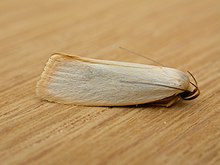Gelechioidea
| Curved-horn moths | |
|---|---|

| |
| Adult Xylorycta assimilis of the Xyloryctidae, photographed in Aranda (Australia) Note prominent "horns" and long antennae | |
| Scientific classification | |
| Domain: | Eukaryota |
| Kingdom: | Animalia |
| Phylum: | Arthropoda |
| Class: | Insecta |
| Order: | Lepidoptera |
| Clade: | Apoditrysia |
| Superfamily: | Gelechioidea Fracker, 1915 |
| Diversity | |
| 16-21 families (see text) | |
Gelechioidea (from the type genus
As of the 1990s, this superfamily was composed of about 1,425
The name "curved-horn moths" refers to one of the few conspicuous features found in (almost) all Gelechioidea, and, at least in the more extreme developments, unique to them: the
Families
The
In 2011 the superfamily was divided into 21 families, based mainly on morphological studies, with adjustments made for some molecular studies. The number of genera and an estimate of the species number are given in parentheses.[5]
- Metachandini, which have sometimes been treated as families.
- Batrachedridae Heinemann & Wocke, 1876 (10 genera, 99 species)
- Blastobasidae Meyrick, 1894 (24 genera, 377 species) – previously considered a subfamily of Coleophoridae.
- ChimabachidaeHeinemann, 1870 (2 genera, 6 species)
- CoelopoetidaeHodges, 1978 (1 genus, 3 species)
- Coleophoridae Bruand, 1850 (case-bearers, case moths; 5 genera, 1,386 species)
- Cosmopterigidae Heinemann & Wocke, 1876 (cosmet moths; 135 genera, 1,792 species)
- Elachistidae Bruand, 1850 (grass-miner moths; 161 genera, 3,201 species) – includes Agonoxeninae (palm moths) and Ethmiinae, which have sometimes been treated as families.
- Epimarptidae Meyrick, 1914 (1 genus, 4 species) – previously considered a subfamily of Batrachedridae.
- Gelechiidae Stainton, 1854 (twirler moths; 500 genera, 4,700 species)
- Lecithoceridae Le Marchand, 1947 (long-horned moths; 100 genera, 1,200 species)
- Lypusidae Herrich-Schäffer, 1857 (3 genera, 21 species)
- Momphidae Herrich-Schäffer, 1857 (mompha moths; 6 genera, 115 species) – previously considered a subfamily of Coleophoridae.
- Oecophoridae Bruand, 1850 (concealer moths; 313 genera, 3,308 species)
- PeleopodidaeHodges, 1974 (7 genera, 28 species)
- Pterolonchidae Meyrick, 1918 (2 genera, 8 species) – previously considered a subfamily of Coleophoridae.
- SchistonoeidaeHodges, 1998 (scavenger moth; 1 genus, 1 species)
- Scythrididae Rebel, 1901 (flower moths; 30 genera, 669 species) – previously considered a subfamily of Xyloryctidae.
- Stathmopodidae Janse, 1917 (44 genera, 408 species) – previously considered a subfamily of Oecophoridae.
- Deoclonidae.
- Xyloryctidae Meyrick, 1890 (60 genera, 524 species)
However, a later phylogenetic analysis of the Gelechioidea, using a morphological and molecular dataset, proposed a revision into 16 families, with the status of two further families,
- Autostichidae Le Marchand, 1947
- Autostichinae Le Marchand, 1947
- Deocloninae Hodges, 1999
- Glyphidocerinae Hodges, 1999
- Holcopogoninae Gozmány, 1967
- Oegoconiinae Leraut, 1992
- Symmocinae Gozmány, 1957
- Batrachedridae Heinemann & Wocke, 1876
- Blastobasidae Meyrick, 1894
- BlastobasinaeMeyrick, 1894
- HolcocerinaeAdamski, 1989
- Coleophoridae Bruand, 1850
- Cosmopterigidae Heinemann in Heinemann & Wocke, 1876
- Antequerinae Hodges, 1978
- Chrysopeleiinae Mosher, 1916
- CosmopteriginaeHeinemann and Wocke, 1876
- Scaeosophinae Meyrick, 1922
- Depressariidae Meyrick, 1883
- AcriinaeKuznetsov and Stekolnikov, 1984
- AeolanthinaeKuznetsov and Stekolnikov, 1984
- Cryptolechiinae Meyrick, 1883
- Depressariinae Meyrick, 1883
- Ethmiinae Busck, 1909
- Hypercalliinae Leraut, 1993
- Hypertrophinae Fletcher, 1929
- Oditinae Lvovsky, 1996
- Peleopodinae Hodges, 1974
- Stenomatinae Meyrick, 1906
- Elachistidae Bruand, 1850 – substantially reduced with movement of five subfamilies to Depressariidae.
- Agonoxeninae Meyrick, 1926
- ElachistinaeBruand, 1850
- Parametriotinae Capuse, 1971
- Gelechiidae Stainton, 1854
- Anacampsinae Bruand, 1850
- Anomologinae Meyrick, 1926
- Apatetrinae Meyrick, 1947
- Dichomeridinae Hampson, 1918
- Gelechiinae Stainton, 1854
- Physoptilinae Meyrick, 1914
- Thiotrichinae Karsholt et al., 2013
- Lecithoceridae Le Marchand, 1947
- Ceuthomadarinae Gozmány, 1978
- Lecithocerinae Le Marchand, 1947
- Torodorinae Gozmány, 1978
- Lypusidae Herrich-Schäffer, 1857
- Chimabachinae Heinemann, 1870
- Lypusinae Herrich-Schäffer, 1857
- Momphidae Herrich-Schäffer, 1857
- Oecophoridae Bruand, 1850
- Oecophorinae Bruand, 1850
- Pleurotinae Toll, 1956
- Pterolonchidae Meyrick, 1918
- CoelopoetinaeHodges, 1978
- PterolonchinaeMeyrick, 1918
- SyringopainaeHodges, 1999
- Scythrididae Rebel, 1901
- Stathmopodidae Meyrick, 1913
- Xyloryctidae Meyrick, 1890
Footnotes
References
![]() Data related to Gelechioidea at Wikispecies See also associated Talk page for comparison of some approaches to gelechioid systematics and taxonomy.
Data related to Gelechioidea at Wikispecies See also associated Talk page for comparison of some approaches to gelechioid systematics and taxonomy.
- Hodges, R.W. (1999): The Gelechioidea. In: Kristensen, N.P. (ed.): Handbuch der Zoologie/Handbook of Zoology (Volume IV – Arthropoda: Insecta. Part 35: Lepidoptera, Moths and Butterflies 1): 131–158. Walter de Gruyter, Berlin & New York. ISBN 3-11-015704-7
- O'Toole, Christopher (ed.) (2002): Firefly Encyclopedia of Insects and Spiders. ISBN 1-55297-612-2
- Robinson, G.S.; Tuck, K.R.; Shaffer, M. and Cook, K. (1994): The smaller moths of South-East Asia. Malaysian Nature Society, Kuala Lumpur.
- Tree of Life Web Project (ToL) (2009): Gelechioidea. Version of 2009-APR-02. Retrieved 2010-APR-22.
- van Nieukerken, Erik J.; Kaila, Lauri; Kitching, Ian J.; Kristensen, Niels P.; Lees, David C.; Minet, Joël; Mitter, Charles; Mutanen, Marko; Regier, Jerome C.; Simonsen, Thomas J.; Wahlberg, Niklas; Yen, Shen-Horn; Zahiri, Reza; Adamski, David; Baixeras, Joaquin; Bartsch, Daniel; Bengtsson, Bengt Å.; Brown, John W.; Bucheli, Sibyl Rae; Davis, Donald R.; De Prins, Jurate; De Prins, Willy; Epstein, Marc E.; Gentili-Poole, Patricia; Gielis, Cees; Hättenschwiler, Peter; Hausmann, Axel; Holloway, Jeremy D.; Kallies, Axel; Karsholt, Ole; Kawahara, Akito Y.; Koster, Sjaak (J.C.); Kozlov, Mikhail V.; Lafontaine, J. Donald; Lamas, Gerardo; Landry, Jean-François; Lee, Sangmi; Nuss, Matthias; Park, Kyu-Tek; Penz, Carla; Rota, Jadranka; Schintlmeister, Alexander; Schmidt, B. Christian; Sohn, Jae-Cheon; Solis, M. Alma; Tarmann, Gerhard M.; Warren, Andrew D.; Weller, Susan; Yakovlev, Roman V.; Zolotuhin, Vadim V.; Zwick, Andreas (23 December 2011). Zhang, Zhi-Qiang (ed.). "Order Lepidoptera Linnaeus, 1758" (PDF). Zootaxa. Animal biodiversity: An outline of higher-level classification and survey of taxonomic richness. 3148: 212–221.
- Heikkilä, Maria; Mutanen, Marko; Kekkonen, Mari; Kaila, Lauri (2014). "Morphology reinforces proposed molecular phylogenetic affinities: a revised classification for Gelechioidea (Lepidoptera)". Cladistics. 30 (6): 563–589. S2CID 84696495.
